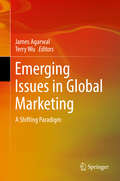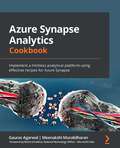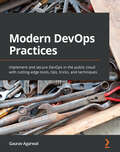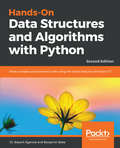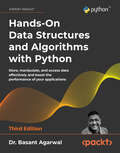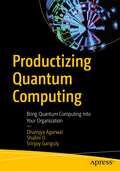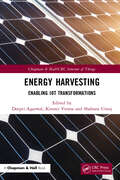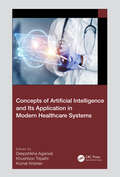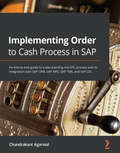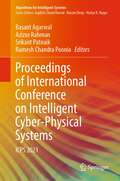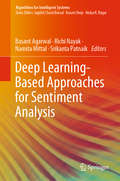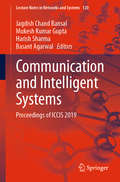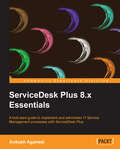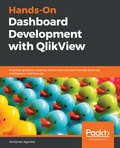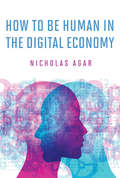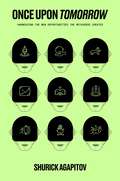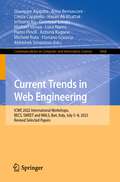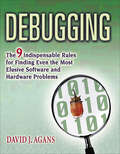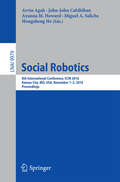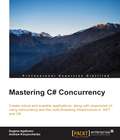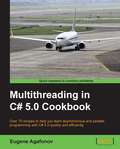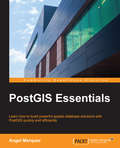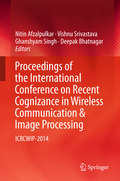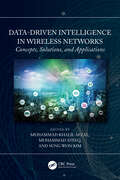- Table View
- List View
Emerging Issues in Global Marketing: A Shifting Paradigm
by James Agarwal Terry WuThis book examines emerging theories, frameworks, and applications of global marketing for the 21st century. It highlights how global marketing is changing in a globalized and digital economy that is fast increasing in complexity and uncertainty. The traditional approach to global marketing is no longer sufficient to address the emerging issues in global markets. Global companies need to challenge traditional assumptions in global marketing in an era of shifting political, cultural, economic, and technological changes. They need to take a fresh look at the contemporary threats and opportunities in markets, institutions, and technology and how they affect entry and expansion strategies through careful re-calibration of the marketing-mix. This book offers new insights for global marketing that addresses these issues. This book should be an ideal resource to both academic scholars and reflective practitioners globally such as CEOs and chief marketing officers as well as government officials and policy makers interested in formulating strategies/policies for global marketing activities in the face of a globalized and digitized economy. This well-crafted research volume is an excellent addition to the growing literature on new trends in international marketing. The authors present the latest insight on the impact of phenomena such as cross-border e-commerce and digital markets, and they discuss new tools for political risk assessment, international branding and more broadly the reconfiguring of marketing-mix strategies – A powerful reminder that the new global market remains a rugged landscape. - Alain Verbeke, McCaig Research Chair in Management and Editor-in-Chief Journal of International Business Studies, University of Calgary, Canada. Emerging trends in institutions, markets, and societies, along with new technological advances, are redefining the scope and strategy in global marketing. Professors Agarwal and Wu have assembled a remarkable collection of cutting-edge topics and issues that capture the shifting paradigm and contemporary developments in the global marketing field. This is an informative and timely resource that makes a valuable contribution, useful for both scholars and business practitioners of global marketing. - Constantine S. Katsikeas, Arnold Ziff Endowed Research Chair in Marketing & International Management, Editor-in-Chief Journal of International Marketing, University of Leeds, UK. This book presents new and cutting-edge thinking at a time when the traditional views of international marketing need to be scrapped. Convergence forces are creating new opportunities as well as threats on a daily basis, and marketing practitioners as well as scholars must be forewarned as well as forearmed on how to deal with these changes. The real growth is coming from the emerging nations, and the theories that provided sufficient insights ten years ago have been completely outmoded by the ever-accelerating rate of innovation and technological change as well as the pressures to address the needs of all of the firm’s relevant stakeholders. The strategic insights provided here are absolutely invaluable. Don’t miss an opportunity to read this book!! - John B. Ford, Professor of Marketing & International Business, Eminent Scholar & Haislip-Rohrer Fellow, Editor-in-Chief, Journal of Advertising Research, Old Dominion University, USA.
Azure Synapse Analytics Cookbook: Implement a limitless analytical platform using effective recipes for Azure Synapse
by Gaurav Agarwal Meenakshi Muralidharan Rohini SrivathsaWhether you're an Azure veteran or just getting started, get the most out of your data with effective recipes for Azure SynapseKey FeaturesDiscover new techniques for using Azure Synapse, regardless of your level of expertiseIntegrate Azure Synapse with other data sources to create a unified experience for your analytical needs using Microsoft AzureLearn how to embed data governance and classification with Synapse Analytics by integrating Azure PurviewBook DescriptionAs data warehouse management becomes increasingly integral to successful organizations, choosing and running the right solution is more important than ever. Microsoft Azure Synapse is an enterprise-grade, cloud-based data warehousing platform, and this book holds the key to using Synapse to its full potential. If you want the skills and confidence to create a robust enterprise analytical platform, this cookbook is a great place to start. You'll learn and execute enterprise-level deployments on medium-to-large data platforms. Using the step-by-step recipes and accompanying theory covered in this book, you'll understand how to integrate various services with Synapse to make it a robust solution for all your data needs. Whether you're new to Azure Synapse or just getting started, you'll find the instructions you need to solve any problem you may face, including using Azure services for data visualization as well as for artificial intelligence (AI) and machine learning (ML) solutions. By the end of this Azure book, you'll have the skills you need to implement an enterprise-grade analytical platform, enabling your organization to explore and manage heterogeneous data workloads and employ various data integration services to solve real-time industry problems.What you will learnDiscover the optimal approach for loading and managing dataWork with notebooks for various tasks, including MLRun real-time analytics using Azure Synapse Link for Cosmos DBPerform exploratory data analytics using Apache SparkRead and write DataFrames into Parquet files using PySparkCreate reports on various metrics for monitoring key KPIsCombine Power BI and Serverless for distributed analysisEnhance your Synapse analysis with data visualizationsWho this book is forThis book is for data architects, data engineers, and developers who want to learn and understand the main concepts of Azure Synapse analytics and implement them in real-world scenarios.
Modern DevOps Practices: Implement and secure DevOps in the public cloud with cutting-edge tools, tips, tricks, and techniques
by Gaurav AgarwalEnhance DevOps workflows by integrating the functionalities of Docker, Kubernetes, Spinnaker, Ansible, Terraform, Flux CD, CaaS, and more with the help of practical examples and expert tipsKey FeaturesGet up and running with containerization-as-a-service and infrastructure automation in the public cloudLearn container security techniques and secret management with Cloud KMS, Anchore Grype, and Grafeas KritisLeverage the combination of DevOps, GitOps, and automation to continuously ship a package of softwareBook DescriptionContainers have entirely changed how developers and end-users see applications as a whole. With this book, you'll learn all about containers, their architecture and benefits, and how to implement them within your development lifecycle.You'll discover how you can transition from the traditional world of virtual machines and adopt modern ways of using DevOps to ship a package of software continuously. Starting with a quick refresher on the core concepts of containers, you'll move on to study the architectural concepts to implement modern ways of application development. You'll cover topics around Docker, Kubernetes, Ansible, Terraform, Packer, and other similar tools that will help you to build a base. As you advance, the book covers the core elements of cloud integration (AWS ECS, GKE, and other CaaS services), continuous integration, and continuous delivery (GitHub actions, Jenkins, and Spinnaker) to help you understand the essence of container management and delivery. The later sections of the book will take you through container pipeline security and GitOps (Flux CD and Terraform).By the end of this DevOps book, you'll have learned best practices for automating your development lifecycle and making the most of containers, infrastructure automation, and CaaS, and be ready to develop applications using modern tools and techniques.What you will learnBecome well-versed with AWS ECS, Google Cloud Run, and KnativeDiscover how to build and manage secure Docker images efficientlyUnderstand continuous integration with Jenkins on Kubernetes and GitHub actionsGet to grips with using Spinnaker for continuous deployment/deliveryManage immutable infrastructure on the cloud with Packer, Terraform, and AnsibleExplore the world of GitOps with GitHub actions, Terraform, and Flux CDWho this book is forIf you are a software engineer, system administrator, or operations engineer looking to step into the world of DevOps within public cloud platforms, this book is for you. Existing DevOps engineers will also find this book useful as it covers best practices, tips, and tricks to implement DevOps with a cloud-native mindset. Although no containerization experience is necessary, a basic understanding of the software development life cycle and delivery will help you get the most out of the book.
Hands-On Data Structures and Algorithms with Python: Write complex and powerful code using the latest features of Python 3.7, 2nd Edition
by Dr Basant AgarwalLearn to implement complex data structures and algorithms using PythonKey FeaturesUnderstand the analysis and design of fundamental Python data structuresExplore advanced Python concepts such as Big O notation and dynamic programmingLearn functional and reactive implementations of traditional data structuresBook DescriptionData structures allow you to store and organize data efficiently. They are critical to any problem, provide a complete solution, and act like reusable code. Hands-On Data Structures and Algorithms with Python teaches you the essential Python data structures and the most common algorithms for building easy and maintainable applications.This book helps you to understand the power of linked lists, double linked lists, and circular linked lists. You will learn to create complex data structures, such as graphs, stacks, and queues. As you make your way through the chapters, you will explore the application of binary searches and binary search trees, along with learning common techniques and structures used in tasks such as preprocessing, modeling, and transforming data. In the concluding chapters, you will get to grips with organizing your code in a manageable, consistent, and extendable way. You will also study how to bubble sort, selection sort, insertion sort, and merge sort algorithms in detail.By the end of the book, you will have learned how to build components that are easy to understand, debug, and use in different applications. You will get insights into Python implementation of all the important and relevant algorithms.What you will learnUnderstand object representation, attribute binding, and data encapsulationGain a solid understanding of Python data structures using algorithmsStudy algorithms using examples with pictorial representationLearn complex algorithms through easy explanation, implementing PythonBuild sophisticated and efficient data applications in PythonUnderstand common programming algorithms used in Python data scienceWrite efficient and robust code in Python 3.7Who this book is forThis book is for developers who want to learn data structures and algorithms in Python to write complex and flexible programs. Basic Python programming knowledge is expected.
Hands-On Data Structures and Algorithms with Python: Store, manipulate, and access data effectively and boost the performance of your applications, 3rd Edition
by Dr. Basant AgarwalUnderstand how implementing different data structures and algorithms intelligently can make your Python code and applications more maintainable and efficientKey FeaturesExplore functional and reactive implementations of traditional and advanced data structuresApply a diverse range of algorithms in your Python codeImplement the skills you have learned to maximize the performance of your applicationsBook DescriptionChoosing the right data structure is pivotal to optimizing the performance and scalability of applications. This new edition of Hands-On Data Structures and Algorithms with Python will expand your understanding of key structures, including stacks, queues, and lists, and also show you how to apply priority queues and heaps in applications. You'll learn how to analyze and compare Python algorithms, and understand which algorithms should be used for a problem based on running time and computational complexity. You will also become confident organizing your code in a manageable, consistent, and scalable way, which will boost your productivity as a Python developer. By the end of this Python book, you'll be able to manipulate the most important data structures and algorithms to more efficiently store, organize, and access data in your applications.What you will learnUnderstand common data structures and algorithms using examples, diagrams, and exercisesExplore how more complex structures, such as priority queues and heaps, can benefit your codeImplement searching, sorting, and selection algorithms on number and string sequencesBecome confident with key string-matching algorithmsUnderstand algorithmic paradigms and apply dynamic programming techniquesUse asymptotic notation to analyze algorithm performance with regard to time and space complexitiesWrite powerful, robust code using the latest features of PythonWho this book is forThis book is for developers and programmers who are interested in learning about data structures and algorithms in Python to write complex, flexible programs. Basic Python programming knowledge is expected.
Productizing Quantum Computing: Bring Quantum Computing Into Your Organization
by Dhairyya Agarwal Shalini D Srinjoy GangulyLeverage the benefits of quantum computing by identifying business use cases and understanding how to design and develop quantum products and services. This book will guide you to effectively productize quantum computing, including best practices, recommendations, and proven methods to help you navigate the challenges and risks of this emerging technology. The book starts with a thorough introduction to quantum computing, followed by its various algorithms and applications. You will then learn how to build a strong foundation in classical computing, seek practical experience, and stay up-to-date with the latest developments in the field. Moving forward, you will gain an understanding of how to conduct market research to identify business opportunities for quantum computing products and services. The authors then guide you through the process of developing a quantum roadmap and integrating quantum computing into an existing system. This is concluded by a demonstration of how to manage quantum computing projects and how to address their risks and challenges. After reading this book, you will understand quantum computing and how it can be applied to real-world business problems. What You Will Learn Identify business use cases for quantum computing and understand the potential benefits and risks of quantum applicationsDesign and develop quantum products and services by identifying quantum algorithms, programming in quantum languages, and leveraging quantum simulators and hardwareIntegrate quantum computing into existing systemsIntegrate quantum algorithms with classical algorithms Who This Book Is For Product managers, developers, and entrepreneurs who wish to use the potential of quantum computing for their businesses.
Energy Harvesting: Enabling IoT Transformations (Chapman & Hall/CRC Internet of Things)
by Deepti Agarwal Kimmi Verma Shabana UroojEnergy Harvesting: Enabling IoT Transformations gives insight into the emergence of energy harvesting technology and its integration with IoT-based applications. The book educates the reader on how energy is harvested from different sources, increasing the effectiveness, efficiency and lifetime of IoT devices. • Discusses the technology and practices involved in energy harvesting for biomedical, agriculture and automobile industries • Compares the performance of IoT-based devices with and without energy harvesting for different applications • Studies the challenges and issues in the implementation of EH-IoT • Includes case studies on energy-harvesting approach for solar, thermal and RF sources • Analyzes the market and business opportunities for entrepreneurs in the field of EH-IoT. This book is primarily aimed at graduates and research scholars in wireless sensor networks. Scientists and R&D workers in industry will also find this book useful.
Concepts of Artificial Intelligence and its Application in Modern Healthcare Systems
by Deepshikha Agarwal Khushboo Tripathi Kumar KrishenThis reference text presents the usage of artificial intelligence in healthcare and discusses the challenges and solutions of using advanced techniques like wearable technologies and image processing in the sector. Features: Focuses on the use of artificial intelligence (AI) in healthcare with issues, applications, and prospects Presents the application of artificial intelligence in medical imaging, fractionalization of early lung tumour detection using a low intricacy approach, etc. Discusses an artificial intelligence perspective on wearable technology Analyses cardiac dynamics and assessment of arrhythmia by classifying heartbeat using electrocardiogram (ECG) Elaborates machine learning models for early diagnosis of depressive mental affliction This book serves as a reference for students and researchers analyzing healthcare data. It can also be used by graduate and post graduate students as an elective course.
Statistical Methods for Recommender Systems
by Deepak K. Agarwal Bee-Chung ChenDesigning algorithms to recommend items such as news articles and movies to users is a challenging task in numerous web applications. The crux of the problem is to rank items based on users' responses to different items to optimize for multiple objectives. Major technical challenges are high dimensional prediction with sparse data and constructing high dimensional sequential designs to collect data for user modeling and system design. This comprehensive treatment of the statistical issues that arise in recommender systems includes detailed, in-depth discussions of current state-of-the-art methods such as adaptive sequential designs (multi-armed bandit methods), bilinear random-effects models (matrix factorization) and scalable model fitting using modern computing paradigms like MapReduce. The authors draw upon their vast experience working with such large-scale systems at Yahoo! and LinkedIn, and bridge the gap between theory and practice by illustrating complex concepts with examples from applications they are directly involved with.
Implementing Order to Cash Process in SAP: An end-to-end guide to understanding the OTC process and its integration with SAP CRM, SAP APO, SAP TMS, and SAP LES
by Chandrakant AgarwalImplement critical business processes with mySAP Business Suite to integrate key functions that add value to every facet of your organizationKey FeaturesLearn master data concepts and UI technologies in SAP systemsExplore key functions of different sales processes, order fulfillment options, transportation planning, logistics execution processes, and customer invoicingConfigure the Order to Cash process in SAP systems and apply it to your business needsBook DescriptionUsing different SAP systems in an integrated way to gain maximum benefits while running your business is made possible by this book, which covers how to effectively implement SAP Order to Cash Process with SAP Customer Relationship Management (CRM), SAP Advanced Planning and Optimization (APO), SAP Transportation Management System (TMS), SAP Logistics Execution System (LES), and SAP Enterprise Central Component (ECC). You'll understand the integration of different systems and how to optimize the complete Order to Cash Process with mySAP Business Suite. With the help of this book, you'll learn to implement mySAP Business Suite and understand the shortcomings in your existing SAP ECC environment. As you advance through the chapters, you'll get to grips with master data attributes in different SAP environments and then shift focus to the Order to Cash cycle, including order management in SAP CRM, order fulfillment in SAP APO, transportation planning in SAP TMS, logistics execution in SAP LES, and billing in SAP ECC. By the end of this SAP book, you'll have gained a thorough understanding of how different SAP systems work together with the Order to Cash process. What you will learnDiscover master data in different SAP environmentsFind out how different sales processes, such as quotations, contracts, and order management, work in SAP CRMBecome well-versed with the steps involved in order fulfillment, such as basic and advanced ATP checks in SAP APOGet up and running with transportation requirement and planning and freight settlement with SAP TMSExplore warehouse management with SAP LES to ensure high transparency and predictability of processesUnderstand how to process customer invoicing with SAP ECCWho this book is forThis book is for SAP consultants, SME managers, solution architects, and key users of SAP with knowledge of end-to-end business processes. Customers operating SAP CRM, SAP TMS, and SAP APO as part of daily operations will also benefit from this book by understanding the key capabilities and integration touchpoints. Working knowledge of SAP ECC, SAP CRM, SAP APO, SAP TMS, and SAP LES is necessary to get started with this book.
Proceedings of International Conference on Intelligent Cyber-Physical Systems: ICPS 2021 (Algorithms for Intelligent Systems)
by Basant Agarwal Azizur Rahman Ramesh Chandra Poonia Srikant PatnaikThis book presents innovative work by leading academics, researchers, and experts from industry which is useful for young researchers and students. This book includes selected papers from International Conference on Intelligent Cyber-Physical Systems (ICPS 2021), held at Indian Institute of Information Technology Kota (IIIT Kota), MNIT Jaipur Campus, Jaipur, India, during 16-18 April 2021. The book is a collection of the state-of-the art research work in the cutting-edge technologies related to the artificial intelligence and cyber physical systems.
Deep Learning-Based Approaches for Sentiment Analysis (Algorithms for Intelligent Systems)
by Basant Agarwal Namita Mittal Srikanta Patnaik Richi NayakThis book covers deep-learning-based approaches for sentiment analysis, a relatively new, but fast-growing research area, which has significantly changed in the past few years. The book presents a collection of state-of-the-art approaches, focusing on the best-performing, cutting-edge solutions for the most common and difficult challenges faced in sentiment analysis research. Providing detailed explanations of the methodologies, the book is a valuable resource for researchers as well as newcomers to the field.
Communication and Intelligent Systems: Proceedings of ICCIS 2019 (Lecture Notes in Networks and Systems #120)
by Basant Agarwal Jagdish Chand Bansal Harish Sharma Mukesh Kumar GuptaThis book gathers selected research papers presented at the International Conference on Communication and Intelligent Systems (ICCIS 2019), organised by Swami Keshvanand Institute of Technology, Management & Gramothan (SKIT), Jaipur, India and Rajasthan Technical University, Kota, India on 9–10 November 2019.This book presents a collection of state-of-the-art research work involving cutting-edge technologies for communication and intelligent systems. Over the past few years, advances in artificial intelligence and machine learning have sparked new research efforts around the globe, which explore novel ways of developing intelligent systems and smart communication technologies. The book presents single- and multi-disciplinary research on these themes in order to make the latest results available in a single, readily accessible source.
ServiceDesk Plus 8.x Essentials
by Ankush AgarwalThis is a practical, hands-on guide that assists you in setting up and efficiently managing ITSM.ServiceDesk Plus 8.x Essentials is for IT helpdesk managers, administrators, and staff, serving as a compendium for service management concepts useful for them.
Hands-On Dashboard Development with QlikView: Practical guide to creating interactive and user-friendly business intelligence dashboards
by Abhishek AgarwalA step-by-step approach to building stunning dashboards with QlikView Key Features Perform effective storytelling through interactive dashboards built with QlikView Create different types of visualizations from a variety of data sources Includes tips, tricks, and best practices to perform effective Business Intelligence using QlikView Book Description QlikView is one of the market leaders when it comes to building effective Business Intelligence solutions. This book will show how you can leverage its power to build your own dashboards to tell your own data story. The book starts with showing you how to connect your data to QlikView and create your own QlikView application. You will learn how to add data from multiple sources, create a data model by joining data, and then review it on the front end. You will work with QlikView components such as charts, list boxes, input boxes, and text objects to create stunning visualizations that help give actionable business insights. You will also learn how to perform analysis on your data in QlikView and master the various types of security measures to be taken in QlikView. By the end of this book, you will have all the essential knowledge required for insightful data storytelling and creating useful BI dashboards using QlikView. What you will learn Learn to use the latest and newest features of QlikView Connect QlikView to various data sources, such as databases and websites Create a fully featured data model without circular references Display your data in maps, charts, and text across multiple sheets Apply set analysis to your data in QlikView expressions Secure your data based on the various audience types Who this book is for This book is best suited for BI professionals, data analysts and budding QlikView developers who wish to build effective dashboards using QlikView. Some basic understanding of the data visualization concepts and Business Intelligence is required.
How to Be Human in the Digital Economy (The\mit Press Ser.)
by Nicholas AgarAn argument in favor of finding a place for humans (and humanness) in the future digital economy.In the digital economy, accountants, baristas, and cashiers can be automated out of employment; so can surgeons, airline pilots, and cab drivers. Machines will be able to do these jobs more efficiently, accurately, and inexpensively. But, Nicholas Agar warns in this provocative book, these developments could result in a radically disempowered humanity.The digital revolution has brought us new gadgets and new things to do with them. The digital revolution also brings the digital economy, with machines capable of doing humans' jobs. Agar explains that developments in artificial intelligence enable computers to take over not just routine tasks but also the kind of “mind work” that previously relied on human intellect, and that this threatens human agency. The solution, Agar argues, is a hybrid social-digital economy. The key value of the digital economy is efficiency. The key value of the social economy is humanness.A social economy would be centered on connections between human minds. We should reject some digital automation because machines will always be poor substitutes for humans in roles that involve direct contact with other humans. A machine can count out pills and pour out coffee, but we want our nurses and baristas to have minds like ours. In a hybrid social-digital economy, people do the jobs for which feelings matter and machines take on data-intensive work. But humans will have to insist on their relevance in a digital age.
Once Upon Tomorrow: Harnessing the New Opportunities the Metaverse Creates
by Shurick AgapitovShurick Agapitov&’s Once Upon Tomorrow unpacks the sometimes vague concept of the metaverse and shares the opportunities that are and will be available within this new world.Thirty years ago, the advent of the internet changed the world. For the first time in human history, the collected knowledge of all mankind was freely available to every man, woman, and child on the planet with the click of a few buttons. Fifteen years ago, the world changed again with the widespread availability and adoption of smartphones that put the full power of the internet in the palm of our hands whenever we want and wherever we are. As monumental as these advancements were, they were just the warmup for the change that&’s coming next. In just a few years, we won&’t think of &“going on the internet&” to look up information and find entertainment. Instead, we&’ll already be in the internet, living, working, and playing in an endless virtual world that will turn everything we think we know about the internet on its head. Welcome to the Metaverse. In Once Upon Tomorrow, visionary tech CEO Shurick Agapitov dives deep into this new age of the internet by unpacking exactly what the Metaverse is and what it will become. It&’s not about pixels and computer chips; it&’s a total paradigm shift what will revolutionize how people interact, share stories, create and implement ideas, conduct business, and literally live their lives. The Metaverse will be the biggest change any of us have ever seen. Fortunately, Shurick Agapitov is here to take you by the hand and welcome you into this wild, wonderful new universe of opportunity.
Current Trends in Web Engineering: ICWE 2022 International Workshops, BECS, SWEET and WALS, Bari, Italy, July 5-8, 2022, Revised Selected Papers (Communications in Computer and Information Science Series #1668)
by Giuseppe Agapito Anna Bernasconi Cinzia Cappiello Hasan Ali Khattak InYoung Ko<p>This volume constitutes the papers of several workshops which were held in conjunction with the ICWE 2022 International Workshops, BECS, SWEET and WALS, held in Bari, Italy, July 5–8, 2022. The 14 revised full papers and 1 short paper presented in this book were carefully reviewed and selected from 25 submissions.<p> <p>ICWE 2022 presents the following three workshops:<p> <p>Second International Workshop on Big Data driven Edge Cloud Services (BECS 2022)<p> <p>First International Workshop on the Semantic WEb of Everything (SWEET 2022)<p> <p>First International Workshop on Web Applications for Life Sciences (WALS 2022)<p>
Debugging: The 9 Indispensable Rules for Finding Even the Most Elusive Software and Hardware Problems
by David J. AgansWhen the pressure is on to resolve an elusive software or hardware glitch, what&’s needed is a cool head courtesy of a set of rules guaranteed to work on any system, in any circumstance.Written in a frank but engaging style, this book provides simple, foolproof principles guaranteed to help find any bug quickly. Recognized tech expert and author David Agans changes the way you think about debugging, making those pesky problems suddenly much easier to find and fix.Agans identifies nine simple, practical rules that are applicable to any software application or hardware system, which can help detect any bug, no matter how tricky or obscure. Illustrating the rules with real-life bug-detection war stories, Debugging shows you how to:Understand the system: how perceiving the ""roadmap"" can hasten your journeyQuit thinking and look: when hands-on investigation can&’t be avoidedIsolate critical factors: why changing one element at a time can be an essential toolKeep an audit trail: how keeping a record of the debugging process can win the dayWhether the system or program you&’re working on has been designed wrong, built wrong, or used wrong, Debugging helps you think correctly about bugs, so the problems virtually reveal themselves.
Social Robotics
by Arvin Agah John-John Cabibihan Ayanna M. Howard Miguel A. Salichs Hongsheng HeThis book constitutes the refereed proceedings of the 8th International Conference on Social Robotics, ICSR 2016, held in Kansas City, MO, USA, in November 2016. The 98 revised full papers presented were carefully reviewed and selected from 107 submissions. The theme of the 2016 conference is Sociorobotics: Design and implementation of social behaviors of robots interacting with each other and humans. In addition to technical sessions, ICSR 2016 included three workshops: The Synthetic Method in Social Robotics (SMSR 2016), Social Robots: A Tool to Advance Interventions for Autism, and Using Social Robots to Improve the Quality of Life in the Elderly.
Mastering C# Concurrency
by Eugene Agafonov Andrew KoryavchenkoCreate robust and scalable applications along with responsive UI using concurrency and the multi-threading infrastructure in .NET and C#About This BookLearn to combine your asynchronous operations with Task Parallel LibraryMaster C#'s asynchronous infrastructure and use asynchronous APIs effectively to achieve optimal responsiveness of the applicationAn easy-to-follow, example-based guide that helps you to build scalable applications using concurrency in C#Who This Book Is ForIf you are a C# developer who wants to develop modern applications in C# and wants to overcome problems by using asynchronous APIs and standard patterns, then this book is ideal for you. Reasonable development knowledge, an understanding of core elements and applications related to the .Net platform, and also the fundamentals of concurrency is assumed.What You Will LearnApply general multithreading concepts to your application's designLeverage lock-free concurrency and learn about its pros and cons to achieve efficient synchronization between user threadsCombine your asynchronous operations with Task Parallel LibraryMake your code easier with C#'s asynchrony supportUse common concurrent collections and programming patternsWrite scalable and robust server-side asynchronous codeCreate fast and responsible client applicationsAvoid common problems and troubleshoot your multi-threaded and asynchronous applicationsIn DetailStarting with the traditional approach to concurrency, you will learn how to write multithreaded concurrent programs and compose ways that won't require locking. You will explore the concepts of parallelism granularity, and fine-grained and coarse-grained parallel tasks by choosing a concurrent program structure and parallelizing the workload optimally. You will also learn how to use task parallel library, cancellations, timeouts, and how to handle errors. You will know how to choose the appropriate data structure for a specific parallel algorithm to achieve scalability and performance. Further, you'll learn about server scalability, asynchronous I/O, and thread pools, and write responsive traditional Windows and Windows Store applications.By the end of the book, you will be able to diagnose and resolve typical problems that could happen in multithreaded applications.Style and approachAn easy-to-follow, example-based guide that will walk you through the core principles of concurrency and multithreading using C#.
Multithreading in C# 5.0 Cookbook
by Eugene AgafonovCookbook.Multithreading in C# 5.0 Cookbook is written for existing C# developers who want a complete, professional, and authoritative guide to multithreading. You don't need any experience with multithreaded programming to use this book.
Multithreading with C# Cookbook - Second Edition
by Eugene AgafonovOver 70 recipes to get you writing powerful and efficient multithreaded, asynchronous, and parallel programs in C# 6.0 About This Book * Rewritten and updated to take advantage of the latest C# 6 features * Learn about multithreaded, asynchronous, and parallel programming through hands-on, code-first examples * Use these recipes to build fast, scalable, and reliable applications in C# Who This Book Is For This book is aimed at those who are new to multithreaded programming, and who are looking for a quick and easy way to get started. It is assumed that you have some experience in C# and .NET already, and you should also be familiar with basic computer science terminology and basic algorithms and data structures. What You Will Learn * Use C# 6.0 asynchronous language features * Work with raw threads, synchronize threads, and coordinate their work * Develop your own asynchronous API with Task Parallel Library * Work effectively with a thread pool * Scale up your server application with I/O threads * Parallelize your LINQ queries with PLINQ * Use common concurrent collections * Apply different parallel programming patterns * Use Reactive Extensions to run asynchronous operations and manage their options In Detail Multi-core processors are synonymous with computing speed and power in today's world, which is why multithreading has become a key concern for C# developers. Multithreaded code helps you create effective, scalable, and responsive applications. This is an easy-to-follow guide that will show you difficult programming problems in context. You will learn how to solve them with practical, hands-on, recipes. With these recipes, you'll be able to start creating your own scalable and reliable multithreaded applications. Starting from learning what a thread is, we guide you through the basics and then move on to more advanced concepts such as task parallel libraries, C# asynchronous functions, and much more. Rewritten to the latest C# specification, C# 6, and updated with new and modern recipes to help you make the most of the hardware you have available, this book will help you push the boundaries of what you thought possible in C#. Style and approach This is an easy-to-follow guide full of hands-on examples of real-world multithreading tasks. Each topic is explained and placed in context, and for the more inquisitive, there are also more in-depth details of the concepts used.
Proceedings of the International Conference on Recent Cognizance in Wireless Communication & Image Processing
by Nitin Afzalpulkar Vishnu Srivastava Ghanshyam Singh Deepak BhatnagarThis volume comprises the proceedings of the International Conference on Recent Cognizance in Wireless Communication & Image Processing. It brings together content from academicians, researchers, and industry experts in areas of Wireless Communication and Image Processing. The volume provides a snapshot of current progress in computational creativity and a glimpse of future possibilities. The proceedings include two kinds of paper submissions: (i) regular papers addressing foundation issues, describing original research on creative systems development and modeling; and (ii) position papers describing work-in-progress or research directions for computational creativity. This work will be useful to professionals and researchers working in the core areas of wireless communications and image processing.
Data-Driven Intelligence in Wireless Networks: Concepts, Solutions, and Applications
by Muhammad Khalil Afzal Muhammad Ateeq Sung Won KimThis book highlights the importance of data-driven techniques to solve wireless communication problems. It presents a number of problems (e.g., related to performance, security, and social networking), and provides solutions using various data-driven techniques, including machine learning, deep learning, federated learning, and artificial intelligence.This book details wireless communication problems that can be solved by data-driven solutions. It presents a generalized approach toward solving problems using specific data-driven techniques. The book also develops a taxonomy of problems according to the type of solution presented and includes several case studies that examine data-driven solutions for issues such as quality of service (QoS) in heterogeneous wireless networks, 5G/6G networks, and security in wireless networks. The target audience of this book includes professionals, researchers, professors, and students working in the field of networking, communications, machine learning, and related fields.
